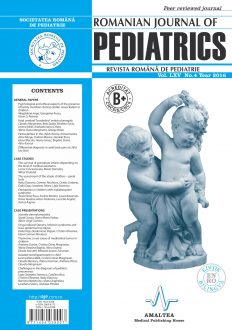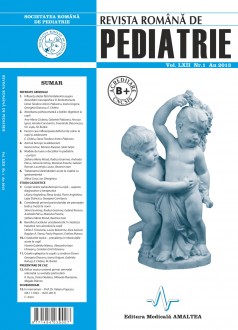SELECT ISSUE

Indexed

| |

|
|
|
| |
|
|
|

|
|
|
|
|
|
|
HIGHLIGHTS
National Awards “Science and Research”
NEW! RJP has announced the annually National Award for "Science and Research" for the best scientific articles published throughout the year in the official journal.
Read the Recommendations for the Conduct, Reporting, Editing, and Publication of Scholarly work in Medical Journals.
The published medical research literature is a global public good. Medical journal editors have a social responsibility to promote global health by publishing, whenever possible, research that furthers health worldwide.
OSTEOPENIA LA COPIII CU SINDROAME DE MALABSORBTIE
Tania Elena Rusu, Evelina Moraru, Laura Bozomitu, Dana Teodora Anton Păduraru, Lucretia Anghel and Aurica Rugina
REZUMAT
Introducere. Sindroamele de malabsorbţie au drept consecinţă perturbarea dezvoltării şi funcţiei normale a sistemului osos.
Obiective. Aprecierea densităţii osoase la copiii cu sindroame de malabsorbţie. Analiza factorilor de risc pentru osteopenie. Evaluarea corelaţiilor între osteopenie, markerii nutriţionali şi markerii metabolismului osos.
Material şi metodă. 118 copii cu sindrom de malabsorbţie de diverse etiologii, în principal boală celiacă (41 cazuri) şi fibroză chistică (14 cazuri). Densitatea osoasă a fost evaluată prin Ultrasonografie cantitativă (QUS) utilizând un Osteodensitometru Sunlight Omnisense Ultrasonometer 7000P. QUS a fost efectuată la radius (86 de cazuri) şi tibie (78 de cazuri). 25 hidroxivitamina D a fost evaluată la 10 cazuri prin metoda RIA. Analiza statistică a fost realizată utilizând SPSS for Windows.
Rezultate. Osteopenia a fost prezentă la 32% dintre cazuri. Scăderea densităţii osoase la radius a fost asociată cu sindromul celiachiform. Osteopenia la tibie s-a asociat cu fibroza chistică. Osteopenia a fost mai frecventă la fete. Osteopenia s-a asociat cu durata bolii. Osteopenia nu s-a corelat cu BMI. Scorul Z la radius s-a corelat pozitiv cu nivelele fosfatazei alcaline, iar scorul Z la tibie cu colesterolemia. Scorul Z la tibie şi radius s-a corelat negativ cu valorile markerilor inflamatori. La copiii cu boală celiacă, valoarea anticorpilor anti-transglutaminază s-a corelat negativ cu scorul Z la radius şi tibie. Nivelele 25(OH) vitaminei D au fost deficiente la 8 copii şi insuficiente la 2, dar valorile sale nu s-au corelat cu scorul Z la radius şi tibie. Semne clinice, biologice şi radiologice de rahitism au fost prezente la 35% dintre bolnavii cu osteopenie.
Concluzii. Osteopenia a fost prezentă la 1/3 din bolnavii cu sindrom de malabsorbţie din lotul studiat. 30% dintre bolnavi au avut semne clinice, biologice şi radiologice de rahitism. Valorile 25(OH) vitaminei D nu s-au corelat cu scorul Z. S-a observat o corelaţie negativă între parametrii osoşi şi markerii inflamaţiei şi anticorpii anti-transglutaminază.
Cuvinte cheie: osteopenie, sindroame de malabsorbţie, boală celiacă
Full text | PDF

